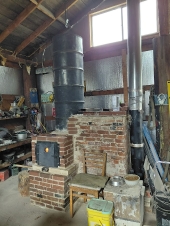




In the early days many people insisted that a normal vertical chimney was not needed,now most people involved in the making of rocket mass heater seem to think it is best practice to use these kinds of chimneys.




I was thinking of bluegill in the upper basin for cold hardiness and low maintenance (and because they are readily available in the pond), but the yields seem like they would be pretty low relative to tilapia. But tilapia would require a lot more management.
What would you in my situation?

Sam Shade wrote:The complexity and engineering involved in aquaponics has thus far kept me at bay, but I have a couple set ups that keep bring me back to the concept.
First, I have about a half acre pond that is home to the usual assortment of freshwater fish, turtles and algae. My dad is nuts for building water features and so he built a sort of volcano shaped fountain/ pond along side it, using a pump to push water about 8 feet up and then cascade down into a series of large basins (each of which probably hold about 800 gallons) before streaming back into the pond.
Thus I have some quasi aquaponics infrastructure already in place. I already grow water lotus in the lower basin but I would really like to add some fish to the upper basin. I get a few fish out of the big pond with a fishing rod, but I can't shake the appeal of netting dinner out of the mini pond.
The problem is from everything I've read, tilapia is the most efficient fish to raise in a set up like this but I'm in zone 7b, which makes tilapia raising an annual prospect. So I'm on the hunt for an efficient variety that can overwinter in 7b.
The second tempting use of aquaponics has been referenced several times in this thread - since I'm going to be using 200+ gallons of water as thermal mass when I put in my greenhouse, why not get some dual use out of it? I intend to cultivate some water hyacinth if I can keep the greenhouse temperature up, but it sounds be great to utilize more of the water than just the surface area of the openings of my 55 gallon barrels.

Kevin Feinstein II wrote:
I like aquaponics for the fish and the life-force that living water systems provide.